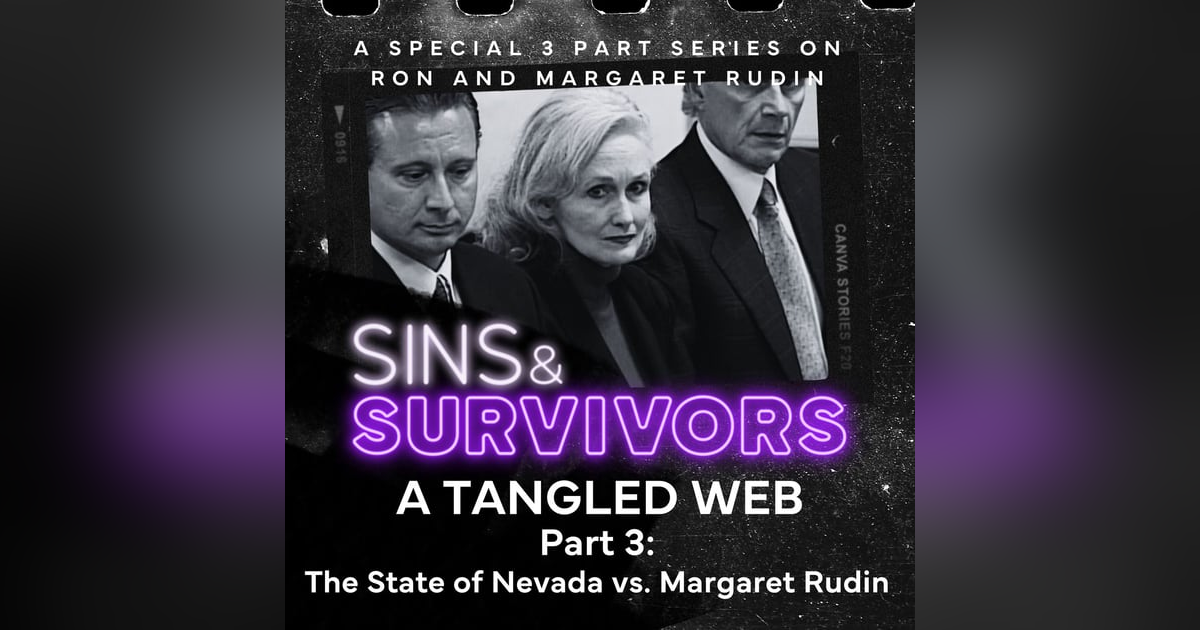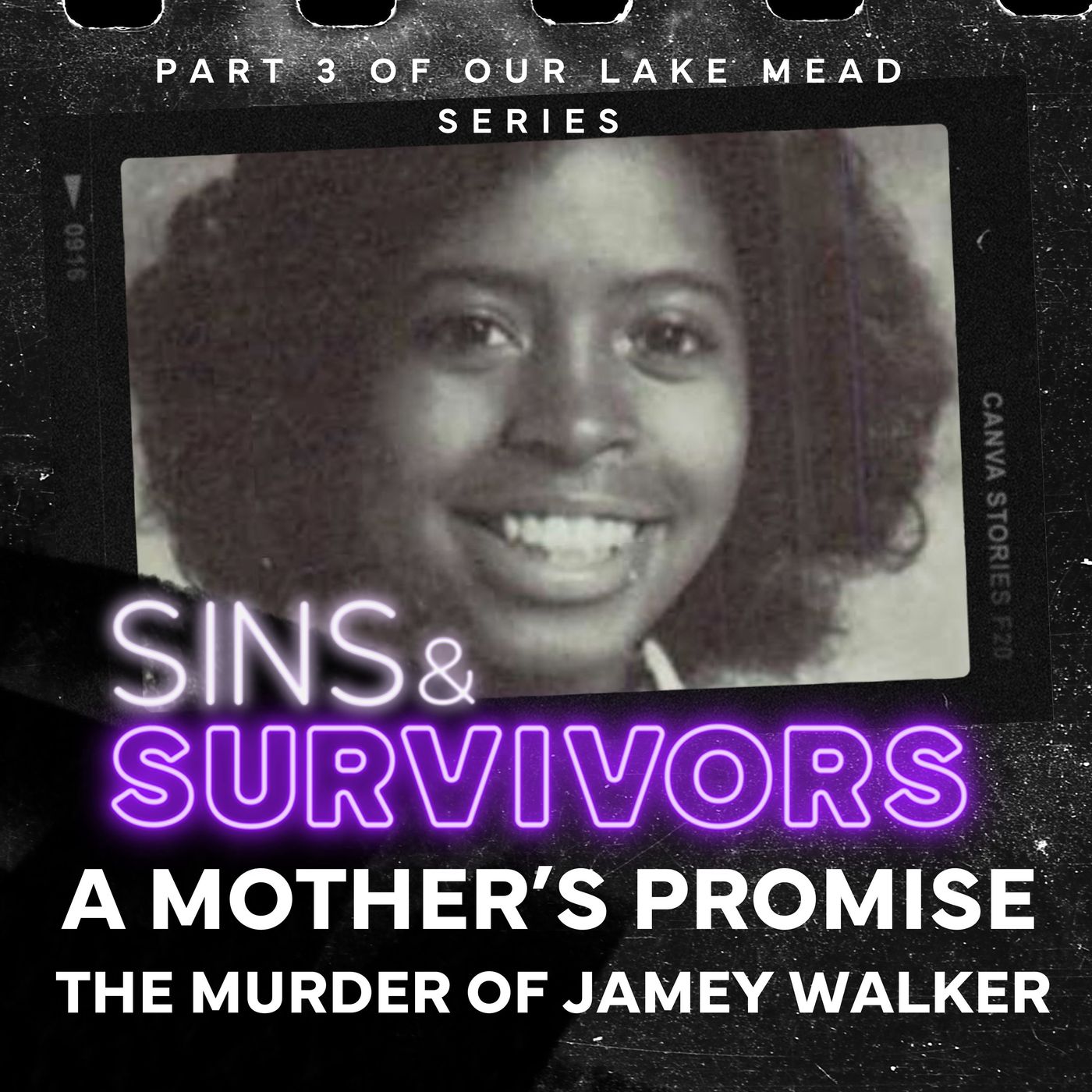A Tangled Web Part 3: The State of Nevada vs Margaret Rudin

Margaret Rudin was known as the Black Widow in the Media, but this week we take a closer look at her trial and everything since.
Margaret Rudin was known as the Black Widow in the Media, but this week we take a closer look at her trial and everything since.
The story of Ron and Margaret Rudin has everything true crime producers and fanatics look for—secret recordings, alleged accomplices, secret lovers, lost evidence, and a trial that could only be described as a circus. But as we close the book, an important question still looms: Did Margaret Rudin really kill Ron Rudin?
…or was she the victim of an overzealous prosecution, ineffective defense, and a media frenzy that branded her 'The Black Widow' before the trial even began? This week, we cover the final years of Margaret’s saga —and whether justice was ever truly served for Ron.
This final episode may leave you questioning everything you thought you knew.
Part 3 of a 3 part series on the so-called Black Widow of Las Vegas.
https://sinspod.co/64sources
Domestic Violence Resources
http://sinspod.co/resources
Click here to become a member of our Patreon!
https://sinspod.co/patreon
Visit and join our Patreon now and access our ad-free episodes and exclusive bonus content & schwag! Get ad-free access for only $1 a month or ad-free and bonus episodes for $3 a month
Apple Podcast Subscriptions
https://sinspod.co/apple
We're now offering premium membership benefits on Apple Podcast Subscriptions! On your mobile device
Let us know what you think about the episode
https://www.buzzsprout.com/twilio/text_messages/2248640/open_sms
Become a supporter of this podcast: https://www.spreaker.com/podcast/sins-survivors-a-las-vegas-true-crime-podcast--6173686/support.
Episode #66 - A Tangled Web Part 3: State of Nevada vs. Margaret Rudin
[Shaun]
The story of Ron and Margaret Rudin has everything true crime producers and fanatics look for—secret recordings, alleged accomplices, secret lovers, lost evidence, and a trial that could only be described as a circus. But as we close the book, an important question still looms: Did Margaret Rudin really kill Ron Rudin?
[John]
…or was she the victim of an overzealous prosecution, ineffective defense, and a media frenzy that branded her 'The Black Widow' before the trial even began? This week, we cover the final years of Margaret’s saga —and whether justice was ever truly served for Ron.
This final episode may leave you questioning everything you thought you knew.
---8-second pause---
[Shaun]
Hi and welcome to Sins and Survivors, a Las Vegas true crime podcast, where we focus on cases that deal with domestic violence, as well as missing persons and unsolved cases.
I’m your host, Shaun.
[John]
And I’m your co-host John.
[Shaun]
Welcome to the 3rd and final part of our series on the murder of Ron Rudin and the trial of Margaret Rudin. I’ve wanted to cover this story since we started the podcast, and with everything that’s happened just in this past year, I’m glad we were finally able to create these episodes and bring them to all of you. Thank you again to Elizabeth Atwood for her help with research.
If you haven’t listened to parts 1 and 2 yet, of course, we recommend you go back and listen to them, especially because this episode is going to focus on the trial, so it will be helpful to be familiar with the details of the investigation.
Briefly, Ron Rudin and Margaret Rudin were married in 1987, and by all accounts, their marriage was very tumultuous. Ron disappeared on December 18, 1994, and many people in their circle pointed the finger at Margaret. When Margaret reported him missing, the police did a cursory search of the property and found nothing indicating something violent had happened in the home.
One of the main reasons people believed Margaret was responsible, was that, without naming her specifically, Ron had executed a secret directive to the trustees of his estate that they take "extraordinary steps" to investigate the cause of his death if he died by "violent means." The directive also provided that any beneficiary who caused his death was not to receive any assets from his estate.
There was also evidence that Margaret had bugged Ron’s offices and had been listening in on his conversations, which raised suspicions.
In January of 1995, Ron’s remains were found in Nelson’s Landing NV. He’d had been shot in the head four times and his body had been burned.
A handyman named Augustine Lovato came forward to the police, claiming to have helped Margaret clean out the couple’s bedroom, and that he had seen large amounts of what he thought was blood on the carpet and padding under the couple’s bed, as well as blood bubbling in the bathtub drain and splattered on a large portrait of Margaret.
When the grand jury indicted Margaret in April of 1997, law enforcement was shocked to find she had left Nevada. She evaded authorities for 2 years with false identities but was finally caught in Massachusetts and extradited to Nevada, where she pleaded not guilty to the charges of murder with use of a deadly weapon; accessory to murder; and of unauthorized surreptitious intrusion of privacy by listening device.
[John]
Because the trustees of Ron’s will cut her off financially, Margaret had limited funding to hire an attorney, but luckily attorney Michael Amador agreed to represent her pro bono. At least, at the time it seemed lucky.
During the trial, Amador faced allegations of creating a prejudicial conflict of interest by reportedly negotiating deals for the literary and media rights related to his representation. It was later determined that he had "lied to the court because he had book and movie contracts regarding the Rudin case."
Over the past 2 episodes, we talked about a lot of circumstantial evidence that was collected against Margaret. Her defense was certain that there was evidence in Ron’s business dealings that may indicate another person was responsible for his murder, so the discovery phase in the case was extensive.
Two and a half weeks before the trial began, the court recognized that Amador could not adequately represent Rudin on his own. Following a series of pretrial delays, attorney Thomas Pitaro was appointed to assist Amador with Rudin's defense. Upon joining the case, Pitaro discovered that Amador had not yet reviewed “thousands of pages of discovery” and soon became “concerned about the preparation that had been done for the trial.”
These allegations of Amador’s incompetence continued throughout the trial and for the decades since, and we’ll share some notable examples later.
The trial began on March 2, 2001, in the 8th judicial district, and was presided over by Judge Joseph Bonaventure. It is reported that the DA offered Margaret the opportunity to plea to second-degree murder, where she would have served a sentence of around 5 or 6 years, but Margaret refused, always maintaining her innocence.
[Shaun]
According to court documents, following the State's opening statement by DA Chris Owens, Defense attorney Michael Amador delivered a lengthy meandering word salad of an opening statement in which he said, in part:
“This is a great day, in a lot of different ways. Some days are difficult; some days we hear bad news or we go through a difficult time, but every day, every day, depending on how you look at it, with a few exceptions, can be a celebration. .... This is a great day for me. This is a culmination of a career. The people in this case, we are not strangers; we know each other. Chris and I were sworn in as deputy DAs the same day. And I congratulate Chris on a presentation that was organized and well thought out, the best money can buy. It was really good. ....
If you want to know an opinion about me, I guarantee you'll find some, different ones from different people. Not many people know me. I have few close friends, like Ronald Rudin had few close friends. ....I could be a wonderful, caring father, coaching soccer, and helping kids with their homework, which I did the first time I got married when they were young. Then another day, I might scream at someone, yell at them for I don't know for asking me some question, because I was too busy and I was thinking of something else. .... The difficulty I have at times is communicating to people. I have to look at it and talk to other people and they will bring me back down to earth and say: Mike, what are you trying to say? What are you trying to get across? .... I reviewed again this morning my opening statement and threw most of it away. I don't know, maybe it's just something I do.”
His co-counsel Pitaro later said of his defense that it was“ ‘a farce, and that disturbs me as an attorney․ This has become a sham, a farce, and a mockery; a mockery of our promise to people who are in the criminal justice system that they will have an adequate defense.”
The court sustained many objections by the prosecution during the lengthy opening statement. Nonetheless, the trial proceeded until March 5, when Margaret notified the judge that she was dissatisfied with her defense counsel. She stated that she believed that Amador was not prepared to try the case, but she did not want a mistrial; she just wanted Pitaro, the assisting attorney, to take a more active role in the case.
[John]
In one example of Amador’s errors, he had failed to interview key witnesses, which meant the defense team learned the content of some witnesses' testimony for the first time during the trial.
In one instance, when a witness took the stand, Pitaro “went to get from Mr. Amador the [witness's] file and found nothing inside.”
Reflecting on the situation, Pitaro later stated, “The preparation that you would hope normally would be done before trial starts was being done during the trial.”
But only 10 days later, Margaret again raised concerns that Amador was not adequately prepared, and this time requested a mistrial.
This was denied, although the court appointed Margaret yet another attorney, John Mormot.
Columnist John L Smith wrote:
“It was agonizing to watch. Anyone who has felt compassion for an animal caught in a steel trap can empathize with the painful predicament defense attorney Michael Amador found himself in... Metaphorically speaking, Amador was attempting to chew off his paw to escape the trap that is the Margaret Rudin murder trial. It's a trap he had set for himself.”
Amador tried in the most tactful language he could muster to admit to the court that he was hopelessly in over his head and needed Bonaventure to grant a mistrial.
Courtroom observers had seen that day coming for weeks. Amador, once a top local prosecutor and more recently a successful defense lawyer, seemed totally overwhelmed by this case, which he accepted without the usual fee. Some of his motions to the court were riddled with typographical errors and confusing digressions. Some of his rhetoric wandered so far off point that earlier the previous week Bonaventure finally lost his patience.
Bonaventure didn't allow Amador to exit gracefully. "Do you know how much money was expended in this case, the thousands upon thousands of dollars?" Bonaventure asked.
The request for a mistrial was denied, and the trial continued.
[Shaun]
For their case, the State called over 60 witnesses, but they relied on just a few: Margaret’s sister Dona Cantrell's testimony of Margaret's behavior and statements before Ron's disappearance, and Augustine's testimony of what he had observed while working in Margaret's home.
The state also presented ballistic evidence indicating that Ron had been shot with his own .22 caliber Ruger handgun, and forensic evidence suggesting that Ron had been shot inside the couple’s bedroom.
They also had evidence of an antique trunk being purchased for Margaret’s shop that was no longer in inventory.
Their theory was that Margaret, motivated by a combination of greed and jealousy, had shot Ron while he was asleep in their bedroom with a gun she had hidden from him since 1988, and then put his body inside a trunk from her antique store, took the trunk to Nelson’s Landing, and burned it.
They concluded Ron was shot in his nightclothes since the burned remains that were found did not include any zippers, snaps, or buttons.
The state’s case was far from air-tight. For example, Ron’s bookkeeper, Sharon Melton, had told the grand jury that she had heard gunshots coming from the Rudin home on the morning Ron didn’t show up for work. Since Ron was killed by a gun with a built-in silencer, there's no way that she heard the gunshots that killed Ron.
Also, Augustine testified that on January 12, 1995 he removed carpet with large, rancid stains from Margaret’s bedroom. However, in December, when Ron was first reported missing, Metro officers went to the home and found no signs of violence or anything amiss.
As we mentioned in Part 2, prosecutors were certain that Margaret would not be able to lift and transport Ron’s body alone. They had the theory that Yehuda Sharon was her boyfriend and that he had helped her.
Sharon was granted immunity by the prosecution but offered nothing incriminating or useful at all during the trial. He had a strong alibi and testified that he knew nothing of Ron Rudin's death.
[John]
The defense presented testimony from over twenty witnesses and based their case on an expert's testimony that the forensic evidence did not support the conclusion that Ron was murdered in the couple’s bedroom and that several other people had the motive and opportunity to kill Ron.
There was no direct evidence that connected Margaret to the crime. No fingerprints, no witnesses, no DNA.
The state had found evidence of a few drops of blood in the bedroom that belonged to a male. They were able to match it to Ron, because they had found a handkerchief in the drawer of his bathroom, near his shaving supplies. The cloth had spots of blood on it, and they concluded he had used it to dab his shaving cuts.
The defense’s blood expert testified the amount of blood found in Margaret’s bedroom was “less than a drop of blood from an eye dropper.” An expert for the defense also testified that “there was no evidence of a cleanup.” Had a person been shot in the head in that room as was theorized, there would have been more blood and likely other tissue remnants found.
Because Ron’s 3rd wife Peggy had died by suicide (allegedly) in that room years earlier, luminol testing in the bedroom could not necessarily be attributed to Ron being killed in the room. Also, a piece of tissue belonging to a female was found on the ceiling, which is believed to have come from Peggy.
It would be very difficult to draw a conclusion that Ron was shot in that room based on the blood evidence.
In any event, Ron had lived in the house for 30 years and you’d expect that traces of his blood would be in his house. The bloody hankie they found in his bathroom is evidence of that. It was also established that Ron suffered from nosebleeds.
As we mentioned earlier, when officers searched the house on December 21 they found nothing. One officer even testified that he had gotten down on his hands and knees beside the bed where Ron had allegedly been shot. This was several weeks before Augustine was hired to do the alleged clean-up work and remove a “heavily stained and rancid carpet”, that he claimed was still damp.
And speaking of Augustine, he was the one who had approached Margaret weeks after he helped move the antiques and put up the Christmas tree.
The defense leaned into the idea that Augustine heard about the $25,000 reward offered and, possibly at the urging of his mother, reinserted himself back into her life.
[Shaun]
John DeHaan, a consulting criminalist on fire issues, testified for the defense. He concluded, “The evidence was consistent with the trunk and portions of the body set afire [at Nelson's Landing] using a quantity of gasoline, and not with the entire body having been burned at that site.” DeHaan's conclusion was based, in part, on his opinion that burning an approximately 200-pound human body to the extent that Ron's remains were burned using gasoline would take four or five hours and require “a gallon of gas every three or four minutes… or about 55 gallons. “
I think even in the small town of Nelson’s Landing, a fire that burned for that long wouldn’t have gone unnoticed.
Michael Fleeman wrote about the trial going from bad to worse for the defense when Margaret’s attorneys staged a reenactment of the murder for the jury.
They had a movie set recreated of the bedroom, with one attorney playing Ron, and the other going “Bang bang bang” with a fake gun.
This stunt enraged the court and the prosecution. "Mr. Momot and Mr. Pitaro did some sort of reenactment in front of the jury... very loudly. I think, putting their credibility at risk and making themselves a witness without any basis for doing that. It's more than just the numerous arguments they've been making -- and spontaneously in front of the jury. This is some sort of reenactment. It was unprofessional... I've never seen anything like that.”
Judge Bonaventure was not having it and he scolded the attorneys and told the jurors to disregard what they had just seen.
[John]
On April 23, 2001, after the defense rested, they were contacted by a witness who was able to dispute the testimony regarding the trunk that was used in the crime.
The State had documentation from Margaret’s antique business that showed she had purchased a humpback antique trunk that matched the size and description of the one used during the crime.
The trunk was no longer in her store’s inventory, so the state argued it must have been this trunk that was burned along with Ron’s remains.
It turns out though, that the person who sold the infamous “missing trunk” to Margaret confirmed it was much too small to hold a body, completely undermining the State’s claim. It was more the size of a trunk that would hold roller skates… so this was an entirely different trunk than the one found with the remains.
As a result, the defense filed a motion to dismiss the case, alleging the State withheld exculpatory evidence. Even worse, this wasn’t the only time the State withheld such evidence.
As we said, the case against Margaret was based on circumstantial evidence, and a lot of that evidence was based on Margaret’s demeanor, her behavior when Ron disappeared, her reaction to his body being found, and so on. They claimed she didn’t cry, she wasn’t upset or concerned he was missing.
It wasn’t until late in the trial that the defense became aware of two witnesses that could refute those claims by the prosecution.
Barbara Orcutt, a friend of Margaret’s who lived in the Lee Canyon area, testified that Margaret was concerned about Ron’s disappearance and had asked for help organizing a search in the Mt. Charleston area shortly after he vanished.
Barbara testified she spoke with Margaret on the telephone on December 19, 1994, in the midmorning, and that she asked Barbara to get some wranglers and horses together to go to the Lee Canyon property to look for Ron. Barbara spoke to Margaret five to six times a day on December 19 and 20, 1994, and during those telephone calls, Margaret “was on the verge of tears.”
Similarly, Marena Flores, the Rudins' housekeeper, testified that on December 20, 1994, Margaret “was very sad; she was crying.” Defense attorneys were not aware of these witnesses’ testimony until very late in the trial, and were not able to use this to refute the state’s claims that Margaret did nothing and was unaffected by Ron’s disappearance.
Again, the State was aware of this exculpatory evidence but failed to disclose it to the defense, which could have countered the prosecution’s narrative earlier in the trial.
However, the court ruled that the error was insufficient for a mistrial. Instead, the defense was allowed to reopen its case to include the testimony and inform the jury about the State’s improper withholding of information.
[Shaun]
In addition to these conflicts, three incidents involving Juror Eleven occurred during the trial. The first involved an argument between her and a staff member of a nearby business over a smoking break. It was then revealed that Juror Eleven had improperly communicated with Alternate Juror Three. According to the alternate, Juror Eleven had called and said that she was upset because she was the only person in favor of a not-guilty verdict. The defense again requested a mistrial, but the motion was denied.
Finally, on May 1, allegations surfaced that Juror Eleven had been dishonest during jury selection regarding her connections to law enforcement and past experiences as a crime victim. The State made a motion for her dismissal. Despite these issues and motions from both the defense and prosecution, the district court decided to retain Juror Eleven on the jury throughout the proceedings.
On May 2, 2001, after thirty-eight days of trial and 7 days of deliberation, the jury returned a verdict of guilty of murder with the use of a deadly weapon and unauthorized surreptitious intrusion of privacy by listening device.
After the verdict was read, the clerk polled the jury. According to Michael Fleeman, Juror 11 was crying. The clerk asked her if it was her verdict, and she swallowed and said, “yes.” She then mouthed the words “I’m sorry.” to Margaret.
In a later interview, Juror 11 said she had been the lone hold out, and she said that after extensive pressure from the other jurors, she relented. She claimed that the other jurors had called her an idiot and told her she was “irrational” The foreman, who wame across very proud that he secured this verdict, disputed her claims.
"When [the jury] came back saying guilty of all counts,” Judge Joseph Bonaventure said, “I was surprised. I was surprised at that."
Shortly after the verdict, a juror held an impromptu press conference on the courthouse steps and stated QUOTE
"In his opening remarks ... Amador said, `This is a great day.' I submit to you that today is a great day. Ronald Rudin, his family and the people of the great state of Nevada can [take] comfort in the fact that justice was served today."
For the murder charge, Margaret was sentenced to life in prison with the possibility of parole after twenty years, plus an equal and consecutive sentence for the weapon enhancement. For the unauthorized intrusion of privacy charge, she received a one-year sentence to run concurrently with her life sentence. She was incarcerated at Florence McClure Women’s Correctional Center in North Las Vegas, Nevada.
[John]
Given all we discussed, Margaret filed multiple appeals. In 2004, she appealed and said a mistrial should have been granted because Amador was so ineffective.
However, the Nevada State Supreme Court ruled 4-2 that while Amador was ineffective, his actions were not enough to warrant a new trial because the mistakes were adequately addressed by the district court, by admonishing him and appointing two other attorneys.
(Normally 7 judges would decide, but Myron E. Leavitt, Justice, died in office 3 months before this decision, so, the matter was decided by a six-justice court.)
The Court said she has a right to a “fair trial, not a perfect trial”
The Dissenting judges used that quote from John L Smith we read earlier about how ineffective Amador was. They also pointed out one of the jurors directly quoted Amador’s opening statement when he gave a press conference after the verdict, proving that Amador’s statements had stuck with and prejudiced the jury.
Margaret had some issues over the next few years with obtaining court-appointed appellate attorneys, and as a result, her appeals were delayed. On September 10, 2014, The US 9th Circuit reviewed a finding of the lower court that while Margaret had attempted to file petitions of post-conviction relief, she was unable to apply within the statutory time frame. The question before the court was whether her six-year delay in filing could be excused.
In their decision, the court went through the errors of the appellate attorneys, noting that some of the delays and confusion were caused by the lower court.
They stated that Margaret’s case had been ongoing for 13 years across state and federal courts, during which she had been unable to present potentially valid claims of prejudice caused by her attorneys’ egregious misconduct.
They also stated her original defense counsel engaged in severe professional misconduct during her trial, which also involved prosecutorial misconduct and legal errors, as acknowledged by the Nevada Supreme Court.
[Shaun]
They stated her current attorney had failed to file a protective habeas corpus petition, further blocking her ability to seek federal review, despite indications that competent counsel might have led to a different trial outcome. The evidence against Margaret was not overwhelming, and competent legal representation could have influenced the verdict.
Despite compelling reasons to extend filing deadlines, the court found no “extraordinary circumstances” under legal standards that would justify it.
Frankly, when I read that, I was stunned. The Court issued a lengthy opinion outlining everything that had gone wrong over the past 13 years, including 27 different errors during the trial where any one of them could have been grounds for a mistrial, but failed to allow Margaret to even file a petition because of a deadline that had passed.
If that also sounds completely off the wall to you, even the 9th Circuit agreed.
In something I don’t recall ever hearing happen before, on March 10, 2015, the Ninth Circuit Court of Appeals withdrew this opinion and issued a revised opinion affirming the trial court's decision that Margaret was entitled to a new trial as a direct result of the professional misconduct and prejudicial conflict of interest by Michael Amador.
Her new attorney, Greg Mullanax said, “This case just pissed me off. It really bothered me. So, that’s why I got involved in the case. I just couldn’t believe that no one cared. This was unbelievable. I mean, what if this was your mother stuck in this? I had no idea it was going to end up being like this.”
[John]
I have to say, I agree with his assessment.
While she was incarcerated, Margaret looked out for the younger women in prison with her, helping them with their homework and tutoring them, including teaching Spanish-speaking women English.
In 2018, she was interviewed by the Review-Journal to discuss the inhumane conditions at Florence McClure prison. Margaret filed a federal lawsuit against the state and its top officials claiming abuse, misconduct, and sexism because male prisoners have access to programs for aging inmates that women don’t.
Margaret told the paper she underwent a cataract surgery that was botched, leaving her with double vision, floaters, massive headaches and vertigo. It took 15 months for the prison to schedule a corrective procedure, and she was still awaiting surgery on her second eye.
The Warden Dwight Neven told the RJ that Margaret complicates things by filing lawsuits. He declined to discuss her eye surgery. He said, “Involving attorneys muddies the water. Now the person involved in the treatment’s time is taken away to respond to the litigation.”
Margaret said that she was placed in segregation for 4 months after a fire sprinkler went off in her cell. She wrote, “The fire sprinkler malfunctioned, set off a tsunami of water. No officer came for 15 minutes to unlock my cell door. Black gritty water ruined everything I owned and my legal papers.”
The lawsuit was settled, and the details were not made public, but shortly afterward, Margaret was released on parole.
[Shaun]
Margaret had been sentenced to life with the possibility of parole after 20 years, so she left prison on January 10, 2020. She was 76 years old.
She was described as excited and overwhelmed and in the process of adjusting to her life outside of prison, and it was reported that one of the first things she did was get a fresh cup of coffee.
She said that she planned to stay in the Las Vegas area and attend UNLV to get a bachelor's degree.
Mullanax said that “Her name should be cleared because I don’t think she did it. She is an innocent woman who has been wrongly convicted and she’s been paying the price for the last 20 years.”
Local news also reported that several acquaintances of the couple claimed to be afraid of her and terrified at the idea of her getting out. "I don't think she should ever get out, for any reason," John Reuther, a good friend of Ron’s, told Channel 13.
In 2022, U.S. District Judge Richard Boulware vacated Margaret’s conviction, finding that she had received ineffective counsel from Michael Amador, and was denied the right to a fair trial.
As John L Smith wrote in the Nevada Independent, the ruling was not a determination of her guilt or innocence in Ron Rudin's murder, but a determination that her conviction no longer stands.
With this ruling, the DAs office had 30 days in which to appeal the decision or ask for a new trial. Mullanax said that a new trial would be a ridiculous outcome because she had already served a 20 year sentence.
"Margaret has served her complete sentence in prison and the further prosecution of Margaret Rudin accomplishes nothing," Mullanax said in a statement. "Margaret will be 79 years old in a couple of weeks and would like to live her remaining years in peace."
The DA’s office did not appeal the ruling within the window, and they did not retry the case.
Margaret’s opinion on all this was, “It’s not about the truth. It’s about who has the better attorney.”
[John]
On May 2, 2024, exactly 23 years to the day of her original conviction, Margaret sued the state of Nevada for wrongful conviction. Her main argument was:
“As with many wrongful convictions, Margaret Rudin’s wrongful conviction was based on flimsy evidence, overzealous and inexperienced detectives, and a media frenzy around the crime which led to what even the presiding judge would call in later documentary interviews a ‘circus’ atmosphere of her trial.”
Her attorneys reiterated that there was never any fingerprint or DNA evidence linking Margaret to the crime, not in Ron’s car or on the murder weapon. Also, Ron had made many enemies during his lifetime, including through his “questionable real estate investments.”
They also pointed out that Margaret was physically incapable of carrying out the crime, however, police never identified an accomplice.
They concluded that
“Margaret Rudin, in fact, did not murder Ron Rudin, did not participate in or plan his murder, and does not know who killed Ron Rudin. She is innocent of the crime and has professed her innocence to the crime and involvement in his death for thirty years.”
The lawsuit is still pending and she is seeking a certificate of innocence, compensation for the over 8,000 days of wrongful incarceration, assistance for housing and insurance, and attorney’s fees.
[Shaun]
I think this would be a good time to share some of Margaret’s alternative suspects. One thing Margaret claimed was that Ron was involved in running guns to Colombian drug lords in South America because he had access to so many weapons. He was a licensed gun dealer and he had hundreds of weapons at his disposal at his house.
She also said it might have been the mob or related to one of the women he was having affairs with.
Yehuda Sharon has seemed to heavily imply that the trustees were the ones who stood to profit the most from Ron’s murder.
During the investigation, Metro received tips from 3 different people who said that two men, who may have been posing as police officers, were seen abducting Ron from a motel room at the Oasis Motel and leaving with him by car, a description that would match the evidence obtained from Ron’s car when it was found – that there were shoe prints from multiple men.
There is still hope that a fingerprint lifted from Ron’s car that did not match Ron or Margaret could be examined and lead to a new suspect.
Given everything we have discussed, I don’t believe Margaret could be found guilty beyond a reasonable doubt in this case. For me, there is one piece of forensic evidence that stood out that I haven’t mentioned yet. When Ron’s body was recovered, there was a bullet exit wound. So if the police and prosecutors had been correct in their theory that Ron had been shot in the couple’s bedroom, there would have been a bullet hole either in the wall or the mattress, but none were found.
[John]
We talked a bit in the previous Swing Shift episodes about this, but the reality of this case is that to me it was a horrible miscarriage of justice, with failure after failure of the legal system, and it cost a woman 20 years of her life. It’s a stain on the justice system.
Margaret's murder conviction was dismissed just a few months ago, in December of 2024, 30 years after Ron first disappeared. The charges were dismissed with prejudice, meaning she cannot be tried for these charges again. Margaret said, “I’m very happy, I’m very relieved, but I keep looking over my shoulder.”
Her wrongful conviction lawsuit is still pending. Channel 13 asked Margaret if she thought she’d get her certificate of innocence. Margaret said, “Knowing Nevada and the way they’ve treated me so far, no.” I honestly dont disagree one bit.
[Shaun]
Today, Margaret is living in Illinois with her daughter, grand kids, and great grandkids. She will turn 82 years old in May. It’s been reported that she’s planning to write a book, and I hope she does because I would look forward to reading it.
In 2022, Las Vegas 8 News Now interviewed her and asked her how she felt about the nickname “The Black Widow”
Margaret replied, “I don’t think anybody would dare call me that to my face.”
Of course, when there are any updates about Margaret or Ron’s case, we will be sure to share them with you all.
[John]
Before we go, we do want to mention briefly that Margaret’s lead defense attorney, Michael Amador, passed away in 2021 at age 66, leaving behind 3 sons and 4 grandchildren.
We’d love your feedback on this episode, so please send us an email at podcast@sinsandsurivors.com or reach out to us instagram at sinsandsurvivors and let us know your thoughts or theories or if you have any lingering questions or comments on Ron and Margaret.
Thank you as always for listening and remember what happens here, happens everywhere.







